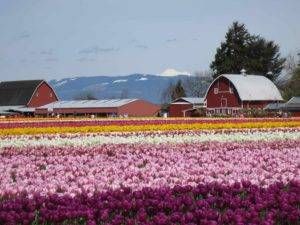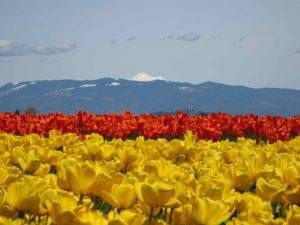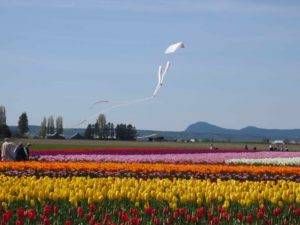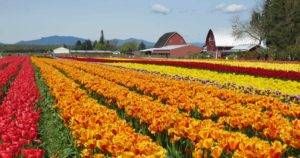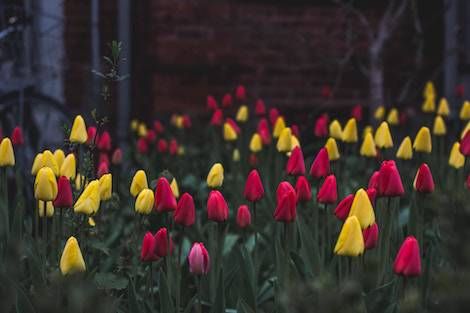
Romance Author Susan Mallery on Tulips, Settings, and “Women’s Fiction”
In the years I’ve been reading romance, I’ve read books set in lots of different small towns – Whiskey Creek, Green Valley, Maplesville. I even cut my romance-reading teeth on Virgin River. (Snicker at the name all you want, but Robyn Carr has sold 10 million books set there over the last decade. So.) I read a lot of different kinds of romance, so I never thought much about my reading habits in connection with the fact that I’m also from a small town.
At least I didn’t think much about it until I started reading Susan Mallery’s Secrets of the Tulip Sisters. About seven pages into that novel, which came out this month, the small towns I’d read about intersected with the place I was born and raised in a very unusual way: I caught on very quickly to the fact that Mallery had set her book in a fictionalized version of the area in Washington State where I grew up.
Washington’s Skagit Valley is best known for the annual Tulip Festival that takes place every April. It’s a big deal. People come from all over to see the tulips. I still remember a high school teacher of mine telling our class her story of buying tulip bulbs in Holland only to get them home and find that they had been in a package stamped, “Imported from Washington State, USA.”
Mallery saw potential here, and Secrets of the Tulip Sisters is the story of two sisters who grew up in the area as daughters of the local tulip farmer. Kelly stayed and has taken over the farming of the tulips, and Olivia is recently returned to the small community after several years away. There’s a lot more to it – humor, secrets, tiny houses, a tall blonde farmer named Sven – but for me the point was that this charming story was unfolding in a place that was quite literally much closer to home than Virgin River.
Even as the insecure teenager still living somewhere inside of me found it a little jarring to read a book with multiple romantic storylines set in a place where I couldn’t get a date for prom, the calmer, adult version of me with a life and (some) social skills was more curious about how and why Mallery, a New York Times bestselling author, had selected the setting. It made me wonder about the decisions and research behind her style of contemporary fiction.
Luckily for me, Susan Mallery was kind enough to answer some of my questions. She speaks eloquently about her creative process, and it’s obvious she puts a tremendous amount of time and energy into researching and writing her books. Although I’ll tell you this: fictional or not, it stings a bit to learn that someone set something called “romance plus” in a place where you once got left behind by a guy you were on a date with.
TB note: The interview is edited for length and clarity.
I have to start out by telling you that I’d never really thought of the small rural area where I grew up as the kind of place where someone would set a novel with a few different romantic storylines.
I think any location is ripe for hot, sexy romance. You can put it together. I mean, no one is a star in their own hometown, so it makes sense you’re a little like, “Really? Are you sure?”
Exactly – I love my hometown, but I don’t know if I would have guessed that someone would visit and think to themselves, “You know what could definitely happen here? A charming story where multiple pairs of people are falling in love.” Was there anything in particular about that area of the world that made you want to tell this particular story there?
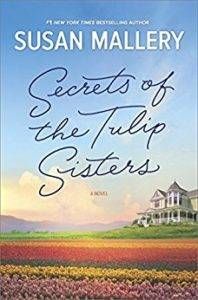
I also went on YouTube and there are hysterically wonderful videos of these totally automated harvesting machines – people never touch the tulips, these are the big farms in Holland, and places like that. I got the scene in my head of Kelly looking at her computer so intently, of her looking at her computer and the hero saying, “Porn?” and it’s not – she’s lusting after this automated machine. And I though, “Ok, I’m in. I’m in.”
It’s not the kind of lust that you normally read about in these kind of books, but why not?
Yes, exactly!
It’s interesting that you talk about picking a setting and looking for a setting that’s unique to set your story, because you set a lot of your books and series in small towns. How do you make them unique and distinct? How do you infuse a small town with enough personality to keep it from just feeling generic?
Part of it is the tone of the books. I write women’s fiction, which would be Mischief Bay. I also write what I would call what I would call “traditional” romance, and the hard covers (including Secrets of the Tulip Sisters) are what my publisher is referring to as “romance plus.” So for me, the tone is different in all three genres. That helps a lot to help keep them different, and I come up with the stories very differently. It’s all about what’s it going to be about.
Do you always have a place that you use for inspiration? Because until I recognized the place that I was from in this book, I wouldn’t have known that you didn’t just create these places out of thin air.
It depends. I grew up in LA. I’m actually an LA girl at heart, so writing about LA is super easy for me, and I’ve lived in Seattle a long time now. I did propose – well, when I write a book, I’ll talk about it, and run some things past my agent and editor and send a two or three paragraph pitch on what the book is going to be about. Because the cosmos works that way – suddenly everyone is writing wedding planners or dog-walkers.
So, I did humorously propose a set of books on the east coast, and I got a phone call back saying, “You’re a west coast writer, you have a west coast voice.” I have no idea what that means, but I choose to believe them, and I’m fine with that.
So, where does inspiration end and imagination begin? At what point do you stop being inspired by the setting that exists and start creating your own space?
I do a lot of research. I take the basics, I did a lot on the tulips, and we’ve all been to those antique malls and you just look at it and think, “you know, this could work if you could just rearrange a few things.” I’ll get the framework and then make it what I need it to be, which is why Tulpen Crossing is not a real town like La Conner, because I knew it didn’t have what I needed it to have.
But you mention La Conner, and you mention the Skagit Valley College, so there are enough landmarks that people can recognize the setting as a real place.
Yeah, I look all of that up. I needed the class that I mentioned at the college, so I looked up the curriculum to make sure it’s there. My search engine is an odd, odd place when I’m starting a book. I take what I need and I create my world. And the concert place is based on a place someone told us about up in Woodinville where they do that sort of thing. And I’m sure their musicians are better than mine, but mine are funny.
For as much of your own creation as there obviously is, the details around both the tulip farming and the tiny houses that Griffith (Kelly’s love interest) is building, don’t seem like the kinds of things that you find on Wikipedia. There’s really specific stuff about things like refrigerating the tulips before planting them. Where did you get that information?
The hero professions can be complicated. For especially that kind of a book, it needs to be grounded. I mean, we always joke that if there were as many Greek tycoons in Greece in real life as there in Harlequin Presents, they would be the richest nation in the world. So, I do try to ground in reality.
And then I’m always looking for something different. I was traveling and I was in a place where there was like nothing on television and I found HGTV had a tiny house marathon and I got hooked on that, and I still buy books. So I got a book of floor plans, and then I did some research and they do tiny homes all over. FEMA is starting to do tiny homes. There’s a place – I believe it’s Chicago – where they changed the zoning law so they can do tiny home lots, and it’s similar to Habitat. You own the home, there’s no mortgage at the end of the process, and then you can sell it, and it allows you to leave a legacy. And a legacy to the next generation is the beginning of wealth. So, that was really exciting to me.
With the tulips, I read as much as I could. There are a lot of scientific papers on hybrids and stuff so I plowed through as much as I could looking through the small words that were in English, so that’s were I learned a lot of it. Some of the stuff was hard. I mean, how long do you refrigerate the tulips? It seemed really specific but finding that exact information was hard. And then, they’re not grown in soil anymore, which is weird, but it makes sense plus it saves a step – you don’t have to clean them. I kept thinking, “They must do something with these fields the rest of the year.” But no. They do not.
You mentioned your book genres earlier, and I’ve written a little about how the term “women’s fiction” bugs me. So I have to ask, given all that you put into your books – given all of the research, given how smart and funny the writing is – do you find that term limiting at all? Do you ever wish that there could be different terminology that would not necessarily box out readers who have a very specific and biased idea of what “women’s fiction” is?
I think that the terminology doesn’t bother me. I am very blessed in that I get to pretty much write what I want to write, and I love what I do and I’ve written a lot of books, and a good writing day is still the best day ever. I know they have to classify it so the bookseller knows where to put it.
I know what you’re saying, because it does put a limitation on it. People will say, “Oh I don’t read those books,” and it’s like, “Yes, you do. You just don’t know you read those books.” And then I’ve had people say, “Well, why isn’t there’s men’s fiction?” Men had the first 500 years. We get one little subgenre for ourselves. No, you don’t get to have a “men’s fiction” section. You have Huckleberry Finn. Go away.
TB Postscript: As I was writing this up, I realized that despite my initial skepticism, Susan is right – any place is ripe for romance. Case in point: my sister met her now husband about nine years ago just north of the small town where we grew up. Ever since, they’ve had the kind of happy, slightly-annoying-but-mostly-adorable relationship that you usually you only see in fiction.
And in a twist that could fit right into Susan’s book, in April of 2013 when they got married, my now brother-in-law ran a few minutes late for his own wedding. Not being a native of the Skagit Valley, he’d forgotten to account for the spring influx of what locals refer to as “tulip traffic.”



